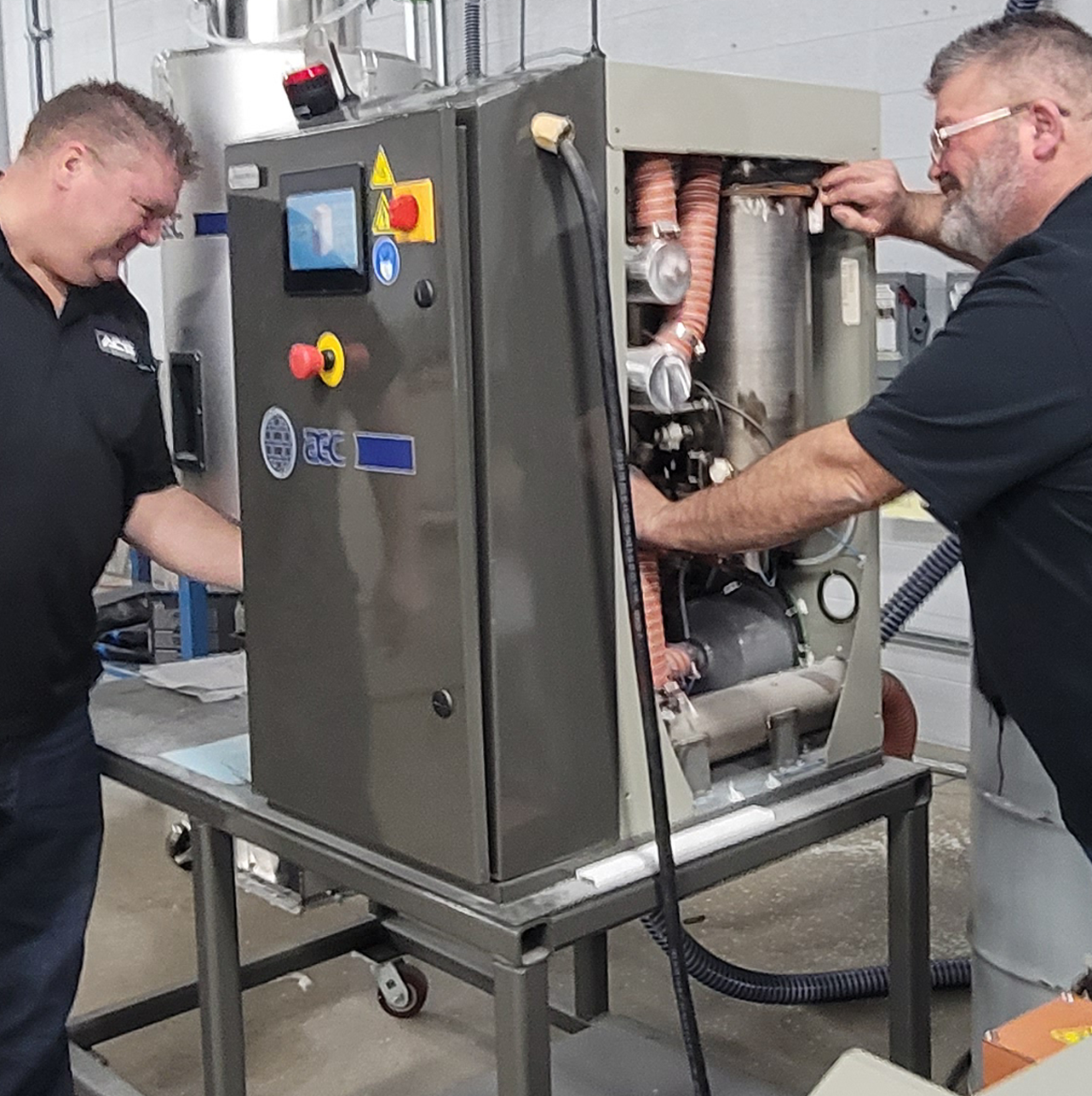Process heaters
To ensure process heaters are properly heating the air to elevate material temperatures – which will aid in removing moisture from the resin – they must be inspected to ensure they are reaching desired temperatures consistently.
If process heaters are slow to reach an optimum temperature or fail to reach the desired temperature, the control parameters may need to be reset or the heater element is likely to be failing (or burned out).
Take the dryer offline before replacing the heater. Replace all the heaters at the same time in a multiple-element setup. Note that if one heater has failed in a heater bank, it is likely others might also be near failure mode. It is good practice to replace all heaters in a bank if there is any uncertainty about their operating condition.
Regeneration heaters
Regeneration heaters are used in the drying process to aid in the moisture removal of the saturated desiccant bed or rotor wheel section. This prepares the desiccant to go online and be at peak efficiency for moisture removal. Temperatures of regeneration heaters are generally preset by the manufacturer.
The effectiveness of regeneration heaters can be monitored by a variety of methods:
- Observing heater contractors, controller lights, thermometers or amp meters.
- Measuring heat output.
- Comparing actual temperature to manufacturer specs.
- Monitoring regeneration exhaust temperatures at the dryer exit point.
- Failure to reach low dew point.
Desiccant beads and wheels
Desiccant materials vary in composition, and therefore usable life.
Desiccant beads, made up of 30% clay binder, break down faster in repeated heating and cooling cycles. This can produce dust that can contaminate resin. Desiccant wheels, made of 100% molecular sieve material, can last up to 15 years (or longer) depending on proper use and maintenance.
To replace desiccant beads
- Turn off the dryer and wait until it cools down.
- Open the desiccant bed container.
- Scoop desiccant out of the bed(s).
- Vacuum out the desiccant dust.
- Pack new beads tightly, avoiding air pockets (vibrate the tank(s) if necessary).
To replace desiccant wheels, replace either the wheel alone or the complete rotor wheel assembly, depending on manufacturer’s recommendation.
Blowers and hoses
Resin drying systems typically use two blowers to maintain the necessary air flow to dry materials: a process blower and a regeneration blower. The process blower is located near the drying hopper or in the drying cabinet, while the regeneration blower is inside the drying cabinet and removes moisture from the desiccant to continue the resin drying process.
To maintain proper airflow, blowers, hoses and filters must be monitored and inspected regularly.
- Examine a blower immediately if it begins making unusual noises.
- Monitor blower amp draws to determine if there are internal signs of wear or damage that would let the blower run at less-than-desired amp range.
- Check hoses for tight connections and holes and replace crimped or crushed hoses. Ensure that you have a system with minimal leakage points.
- Examine hose linings to detect collapses.
Filters
Air filters in resin drying systems maintain optimal airflow and stop dust and fines from contaminating the desiccant and other system components. They also ensure the desiccant is regenerated with clean ambient air.
When using desiccant beads, a plasticizer trap will stop plasticizer contamination.
Failure to maintain the filters of a resin drying system and replace them on schedule will reduce system efficiency and lead to failure of the dryer and the desiccant.
Filters can be vacuumed to remove dust and fines. If distorted or damaged, they cannot be cleaned and must be replaced.
Warm weather maintenance
In warmer months, summer humidity makes resin drying system components work harder when drying material and regenerating desiccant.
The most important aspects of a warm-weather maintenance routine are:
Resin storage
Keep resin bags sealed as long as possible. Put unused resin – particularly glass-filled nylons and some urethanes – in sealed containers to avoid long drying times. Note that some grades of nylon can take up to 16 hours to dry once the material is saturated with moisture.
Hoses
Inspect hoses for dust and other contaminants that can restrict airflow. Check for holes or leaks and insure all clamps are tightened. Properly insulation process air hose and never insulate return air hose.
Filters and filter housings
The presence of oil means a plasticizer is fouling the filters of your resin drying system. Eliminate the plasticizer contaminant by installing an aftercooler and plasticizing trap. Generally, filters can be changed every six months when drying virgin resins, and on a schedule based on appearance when drying regrind or materials with high glass content. When checking filters, also examine the housing for missing or cracked gaskets, lid fasteners and lid fit. Your maintenance schedule is dictated by the machine run time and the type of materials you are drying. When drying materials with long glass fibers, a cyclone separator might be required between the drying hopper and the dryer to maximize dust removal and stop continued blockages of the filter and dryer.



